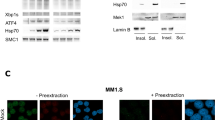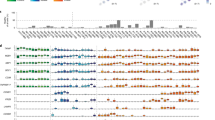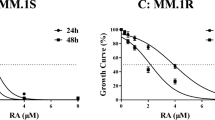Abstract
Aim:
To investigate the effects of serum deprivation (SD) on microvesicles (MVs) secreted from human myeloma cells and the implications for disease progression.
Methods:
RPMI 8226, U266, and KM3 human myeloma cells were incubated in medium containing 10% (non-SD) or 1% fetal bovine serum (SD) and MVs were isolated. The levels and size distribution of MVs were analyzed with flow cytometry. The protein profiles of MVs were studied using 2D SDS-PAGE, MALDI-TOF-MS, and Western blotting. NF-κB activation was analyzed using EMSA. Angiogenesis was examined in Eahy926 endothelial cells.
Results:
Exposure of RPMI 8226 cells to SD for 24 h did not alter the number of apoptotic cells. However, SD increased the number of MVs from RPMI 8226, U266, and KM3 cells to 2.5-, 4.3-, and 3.8-fold, respectively. The size distribution of SD MVs was also significantly different from that of non-SD MVs. Three proteins ZNF224, SARM, and COBL in SD MVs were found to be up-regulated, which were involved in cell cycle regulation, signal transduction and metabolism, respectively. Co-culture of SD MVs and RPMI 8226 cells increased NF-κB activation in the target RPMI 8226 cells. Furthermore, SD MVs from RPMI 8226 cells significantly increased the microtubule formation capacity of Eahy926 endothelial cells compared with non-SD MVs.
Conclusion:
SD elevates the levels of microvesicles with different size distribution and selectively enriched proteins in human myeloma cells in vitro. The selectively enriched proteins, especially ZNF224, may play key roles in regulation of myeloma cells, allowing better adaptation to SD.
Similar content being viewed by others
Log in or create a free account to read this content
Gain free access to this article, as well as selected content from this journal and more on nature.com
or
References
Hanahan D, Weinberg RA . Hallmarks of cancer: the next generation. Cell 2011; 144: 646–74.
Qin S, Chock PB . Implication of phosphatidylinositol 3-kinase membrane recruitment in hydrogen peroxide-induced activation of PI3K and Akt. Biochemistry 2003; 42: 2995–3003.
Kyle RA, Rajkumar SV . Multiple myeloma. N Engl J Med 2004; 351: 1860–73.
Minarík J, Scudla V, Ordeltová M, Bacovský J, Zemanová M, Pika T . Assessment of plasmatic cell proliferation and apoptosis indexes in the course of multiple myeloma. Vnitr Lek 2008; 54: 31–5.
Levin VA, Panchabhai SC, Shen L, Kornblau SM, Qiu Y, Baggerly KA . Different changes in protein and phosphoprotein levels result from serum starvation of high-grade glioma and adenocarcinoma cell lines. J Proteome Res 2010; 9: 179–91.
Tavaluc RT, Hart LS, Dicker DT, El-Deiry WS . Effects of low confluency, serum starvation and hypoxia on the side population of cancer cell lines. Cell Cycle 2007; 6: 2554–62.
Pirkmajer S, Chibalin AV . Serum starvation: caveat emptor. Am J Physiol Cell Physiol 2011; 301: C272–9.
Pervaiz S, Cao J, Chao OS, Chin YY, Clément MV . Activation of the RacGTPase inhibits apoptosis in human tumor cells. Oncogene 2001; 20: 6263–8.
Bernimoulin M, Waters EK, Foy M, Steele BM, Sullivan M, Falet H, et al. Differential stimulation of monocytic cells results in distinct populations of microparticles. J Thromb Haemost 2009; 7: 1019–28.
Piccin A, Murphy WG, Smith OP . Circulating microparticles: pathophysiology and clinical implications. Blood Reviews 2007; 21: 157–71.
Muralidharan-Chari V, Clancy JW, Sedgwick A, D'Souza-Schorey C . Microvesicles: mediators of extracellular communication during cancer progression. J Cell Sci 2010; 123: 1603–11.
Gelderman MP, Simak J . Flow cytometric analysis of cell membrane microparticles. Methods Mol Biol 2008; 484: 79–93.
Shin M, Han Y, Ahn K . The influence of the time and temperature of heat treatment on the allergenicity of egg white proteins. Allergy Asthma Immunol Res 2013; 5: 96–101.
Codeluppi S, Gregory EN, Kjell J, Wigerblad G, Olson L, Svensson CI . Influence of rat substrain and growth conditions on the characteristics of primary cultures of adult rat spinal cord astrocytes. J Neurosci Methods 2011; 197: 118–27.
Pirkmajer S, Chibalin AV . Serum starvation:caveat emptor. Am J Physiol Cell Physiol 2011; 301: C272–9.
Sekiya M, Adachi M, Takayama S, Reed JC, Imai K . IFN-γ upregulates anti-apoptotic gene expression and inhibits apoptosis in IL-3-dependent hematopoietic cells. Biochem Biophys Res Commun 1997; 239: 401–6.
Dolo V, Li R, Dillinger M, Flati S, Manela J, Taylor BJ, et al. Enrichment and localization of ganglioside G(D3) and caveolin-1 in shed tumor cell membrane vesicles. Biochim Biophys Acta 2000; 1486: 265–74.
Medugno L, Florio F, De Cegli R, Grosso M, Lupo A, Costanzo P, et al. The Krüppel-like zinc-finger protein ZNF224 represses aldolase A gene transcription by interacting with the KAP-1co-repressor protein. Gene 2005; 359: 35–43.
O'Neill LA, Fitzgerald KA, Bowie AG . The Toll-IL-1 receptor adaptor family grows to five members. Trends Immunol 2003; 24: 286–90.
Dominguez R . Actin filament nucleation and elongation factors-structure-function relationships. Crit Rev Biochem Mol Biol 2009; 4: 351–66.
Harada Y, Kanehira M, Fujisawa Y, Takata R, Shuin T, Miki T, et al. Cell-permeable peptide DEPDC1-ZNF224 interferes with transcriptional repression and oncogenicity in bladder cancer cells molecular and cellular pathobiology. Cancer Res 2010; 70: 5829–39.
Baud V, Karin M . Is NF-kappaB a good target for cancer therapy? Hopes and pitfalls. Nat Rev Drug Discov 2009; 8: 33–40.
Klein B . Positioning NF-κB in multiple myeloma. Blood 2010; 115: 3422–4.
Berger R, Jennewein C, Marschall V, Karl S, Cristofanon S, Wagner L, et al. NF-κB is required for smac mimetic-mediated sensitization of glioblastoma cells for γ-irradiation-induced apoptosis. Mol Cancer Ther 2011; 10: 1867–75.
Cocucci E, Racchetti G, Meldolesi J . Shedding microvesicles: artefacts no more. Trends Cell Biol 2009; 19: 43–51.
Ginestra A, La Placa MD, Saladino F, Cassarà D, Nagase H, Vittorelli ML . The amount and proteolytic content of vesicles shed by human cancer cell lines correlates with their in vitro invasiveness. Anticancer Res 1998; 18: 3433–7.
Ginestra A, Miceli D, Dolo V, Romano FM, Vittorelli ML . Membrane vesicles in ovarian cancer fluids: a new potential marker. Anticancer Res 1999; 19: 3439–45.
Dainiak N, Sorba S . Intracellular regulation of the production and release of human erythroid-directed lymphokines. J Clin Invest 1991; 87: 213–20.
Wysoczynski M, Ratajczak MZ . Lung cancer secreted microvesicles: underappreciated modulators of microenvironment in expanding tumors. Int J Cancer 2009; 125: 1595–603.
Bianco F, Pravettoni E, Colombo A, Schenk U, Möller T, Matteoli M, et al. Astrocyte-derived ATP induces vesicle shedding and IL-1 beta lease from microglia. J Immunol 2004; 174: 7268–77.
Pizzirani C, Ferrari D, Chiozzi P, Adinolfi E, Sandonà D, Savaglio E, et al. Stimulation of P2 receptors causes release of IL-1 beta-loaded microvesicles from human dendritic cells. Blood 2007; 109: 3856–64.
Pilzer D, Fishelson Z . Mortalin/GRP75 promotes release of membrane vesicles from immune attacked cells and protection from complement-mediated lysis. Int Immunol 2005; 17: 1239–48.
Muralidharan-Chari V, Clancy J, Plou C, Romao M, Chavrier P, Raposo G, et al. ARF6-regulated shedding of tumor cell-derived plasma membrane microvesicles. Curr Biol 2009; 19: 1875–85.
Ambudkar SV, Sauna ZE, Gottesman MM, Szakacs G . A novel way to spread drug resistance in tumor cells: functional intercellular transfer of P-glycoprotein (ABCB1). Trends Pharmacol Sci 2005; 26: 385–7.
Al-Nedawi K, Meehan B, Micallef J, Lhotak V, May L, Guha A, et al. Intercellular transfer of the oncogenic receptor EGFRvIII by microvesicles derived from tumour cells. Nat Cell Biol 2008; 10: 619–24.
Acknowledgements
This research was supported by grants from the National Natural Science Foundation of China (81272624 and 81071943). We thank the Central Lab of Wuhan Central Hospital for the detection and analysis of MVs.
Author information
Authors and Affiliations
Corresponding authors
Additional information
Supplementary figure is available at the Acta Pharmacologic Sinica website.
Supplementary information
Supplementary Figure S1
mRNA expression of VEGF and IL-6 confirmed by semiquantitative RT-PCR. (PDF 255 kb)
Rights and permissions
About this article
Cite this article
Sun, L., Wang, Hx., Zhu, Xj. et al. Serum deprivation elevates the levels of microvesicles with different size distributions and selectively enriched proteins in human myeloma cells in vitro. Acta Pharmacol Sin 35, 381–393 (2014). https://doi.org/10.1038/aps.2013.166
Received:
Accepted:
Published:
Issue date:
DOI: https://doi.org/10.1038/aps.2013.166
Keywords
This article is cited by
-
Synergistic vesicle-vector systems for targeted delivery
Journal of Nanobiotechnology (2024)
-
Enhancing the Cellular Production of Extracellular Vesicles for Developing Therapeutic Applications
Pharmaceutical Research (2023)
-
Different Chronic Stress Paradigms Converge on Endogenous TDP43 Cleavage and Aggregation
Molecular Neurobiology (2023)
-
Comparative Analysis of MSC-Derived Exosomes Depending on Cell Culture Media for Regenerative Bioactivity
Tissue Engineering and Regenerative Medicine (2021)
-
Intricate relationships between naked viruses and extracellular vesicles in the crosstalk between pathogen and host
Seminars in Immunopathology (2018)



